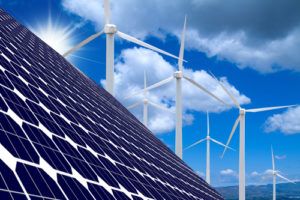
On September 10th, 2018, shortly before the Global Climate Action Summit kicked off in San Francisco, Governor Brown signed Senate Bill (SB) 100,The 100 Percent Clean Energy Act of 2018. The bill received much attention for its two ambitious mandates: (1) accelerating the pace at which California’s investor-owned and publicly-owned electricity providers must achieve renewable portfolio standards (RPS) goals; and (2) establishing a state policy to provide 100% clean energy by December 31, 2045. Governor Brown also signed Executive Order (EO) B-55-18 to Achieve Carbon Neutrality on the same day SB 100 was signed.
This article summarizes SB 100 and the accompanying EO, and highlights land use and California Environmental Quality Act (CEQA) implications of California’s new 100% clean energy policy.
Most notably, SB 100 establishes that 100% of all electricity in California must be obtained from renewable and zero-carbon energy resources by December 31, 2045 – without increasing emissions elsewhere in the western grid. The bill was praised for its flexibility and anticipation of new technological advances that will help agencies and energy providers meet this ambitious target. The California Public Utilities Commission (CPUC), the California Energy Commission (CEC), the California Air Resources Board (CARB), and all other state agencies are charged with incorporating the zero-carbon mandate of SB 100 into relevant planning. Additionally, the CPUC, CEC, and CARB must report on implementation to the legislature by January 1, 2021 and every four years thereafter. Implementation of SB 100 will entail lively public comment processes involving input from diverse stakeholders including energy companies, consumers, environmental advocacy groups, and others.
SB 100 also creates new standards for the RPS goals established by SB 350 in 2015. Specifically, the bill increases required energy from renewable sources for both investor-owned utilities and publicly-owned utilities from 50% to 60% by 2030. Incrementally, these energy providers must also have a renewable energy supply of 33% by 2020, 44% by 2024, and 52% by 2027. The updated RPS goals are considered achievable, since many California energy providers are already meeting or exceeding the RPS goals established by SB 350.
With full implementation of SB 100 by the end of 2045, clean energy will account for 100% of the electricity in the California grid. At least 60% will be provided through renewable energy resources such as wind and solar. The remaining 40% will be provided through a combination of renewable and zero-carbon sources, which are anticipated to include recognized methods like energy storage, as well as new technologies that are yet unknown.
Acknowledging that the energy sector only accounts for about 16 % of the state’s greenhouse gas emissions and explicitly recognizing that “climate change is causing historic droughts, devastating wildfires, torrential storms, extreme heat, the death of millions of trees, billions of dollars in property damage, and threats to human health and food supplies,” and that California’s natural resources “tragically are suffering increasing degradation caused by changing climate,” Governor Brown also signed EO B-55-18 on September 10, 2018. Although not legally enforceable in the same manner as SB 100, the EO establishes a new statewide policy to achieve carbon neutrality (i.e., the point at which removal of carbon pollution from the atmosphere meets or exceeds emissions) no later than 2045, and to achieve and maintain net negative greenhouse gas emissions thereafter. The EO calls on CARB to address this goal in future Scoping Plans, which affect other major sectors of California’s economy, including transportation, agriculture, development, industrial, and others.
There are several land use and CEQA implications of SB 100 and EO B-55-18. Meeting the aggressive goals of SB 100 and EO B-55-18 will require development of significantly more solar, wind, and other carbon neutral energy projects, as well as new technologies to provide and improve energy storage. Since it is unclear that California could reach these targets with solar, wind, and energy storage technology, it raises the contentious issue of new nuclear and hydroelectric power, likely generated outside of California. Even the development of new renewable energy facilities can be controversial because of impacts to agricultural, biological, cultural and other resources. Local and resource agency permitting and CEQA review for these projects takes decades. Thus, while the deadline is many years away, stakeholders will need to act promptly to plan for and begin review of the facilities necessary to achieve these goals. CARB will also likely need to update the Scoping Plan, thus changing how CEQA documents analyze greenhouse gas emissions, energy, and air quality impacts.
